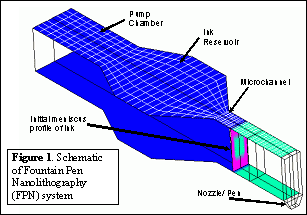|

Technical Problem and Solution
A modified nanolithography technique will be developed for in situ characterization of surface modification obtained by chemical, mechanical, physical means or by their combination (Fig. 5a and 5b). The technique has several benefits:
(i) it enables in situ investigation of surface modification and
| (ii) it provides continuous liquid flow to a sample surface. The in situ character of the technique represents an improvement on the nano-scale tribological investigations, since state-of-the- art studies use the same tip for surface modification and measuring. For example, lithography is done by actuating an integrated |
 |
micropump while subsequent imaging is done with the same probe on a larger area with the micro-pump un-actuated.
The main advantage of this design is that critical phenomena such as material redistribution during scanning can be followed as it occurs or the removal of thin film coatings can be detected in the very same scanning cycle due to friction change. The possibility of providing continuous liquid flow to the scanning probe-tip is important for nanoscale in situ tribological studies of lubricated surfaces. Furthermore, it improves other localized chemical and electro-chemical applications carried out with pulled glass capillaries. Continuous fluid supply may also extend the capabilities of SPL as the amount of ink available for writing in a continuous manner is significantly increased. Also, the availability of a continuous supply of ink materials can be utilized to fabricate a nano-scale array of spots on substrates using FPN techniques. The cross reactivity of the nano-fabricated materials can be studied by in situ monitoring of the surface properties using the pen tips as the reactions occur. The work involves investigating the efficacy of the micropump actuation schemes on the material delivery rates and diffusion coefficients of the ink-materials, effects of the pumping rates on the structure of thin films and rate of material re-distribution in post-lithography steps. The work also involves studying the efficacy of the FPN system for materials synthesis, especially the effect of ink flow rates on the material characteristics/ morphology of the thin film structures and also the effects of the rates of materials synthesis on the material properties of the thin films.
|
|
|
|
|